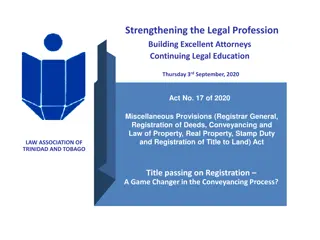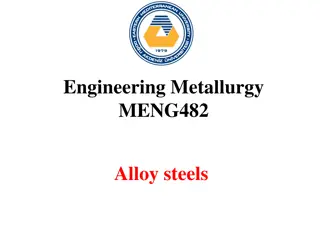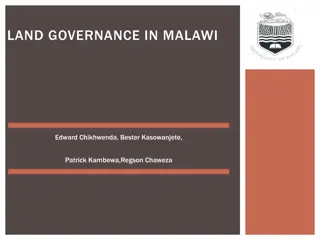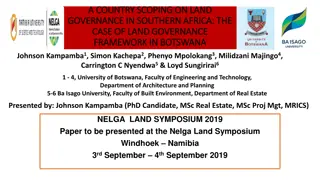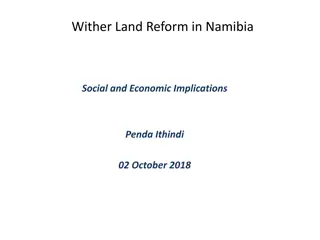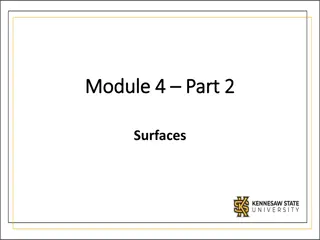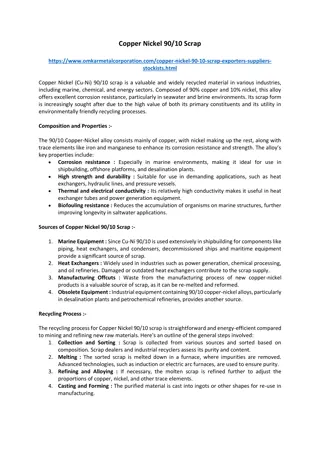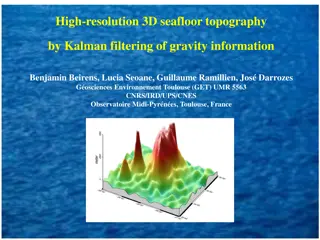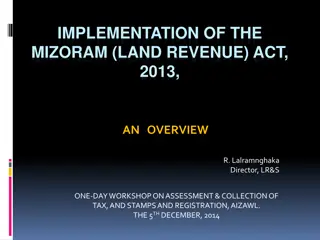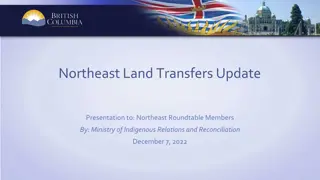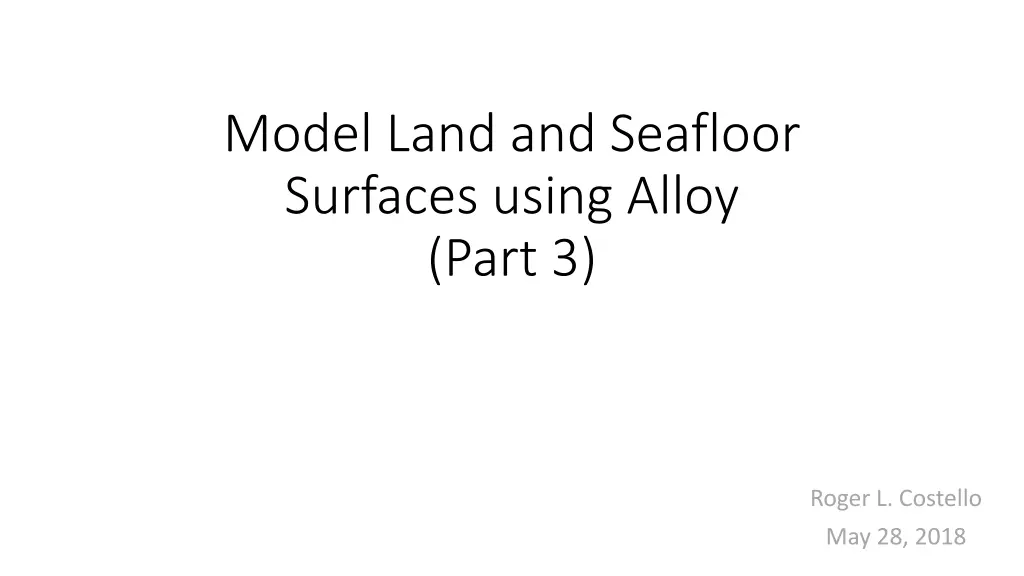
Modeling Land and Seafloor Surfaces Using Alloy - Insights
Delve into the use of Alloy in modeling land and seafloor surfaces, focusing on ADCIRC software tool, wet-dry algorithm, and creating subdomains for simulations. Explore the relationship between full domains and subdomains, and examine how these models impact the behavior of wet and dry areas.
Download Presentation

Please find below an Image/Link to download the presentation.
The content on the website is provided AS IS for your information and personal use only. It may not be sold, licensed, or shared on other websites without obtaining consent from the author. If you encounter any issues during the download, it is possible that the publisher has removed the file from their server.
You are allowed to download the files provided on this website for personal or commercial use, subject to the condition that they are used lawfully. All files are the property of their respective owners.
The content on the website is provided AS IS for your information and personal use only. It may not be sold, licensed, or shared on other websites without obtaining consent from the author.
E N D
Presentation Transcript
Model Land and Seafloor Surfaces using Alloy (Part 3) Roger L. Costello May 28, 2018
The material in these slides come from this paper http://www4.ncsu.edu/~jwb/papers/baugh-scp-2018.pdf
The big picture ADCIRC is the name of a software tool that simulates the movement of water over land and sea. A new version of ARCIRC is being developed. We're trying to show that the simpler (original) implementation and a more complex (enhanced) implementation are equivalent. So the more complex one (which is more efficient) can be used in place of the simpler one. ADCIRC uses an algorithm called the wet-dry algorithm. The algorithm was empirically developed, i.e., it is an empirical algorithm. The algorithm emerged piecemeal over time from the experience and analysis of users and developers, not from a specification. It takes ADCIRC many hours to perform a single simulation of a region, such as simulating the water flow over the North Carolina coastal region. We would like to simulate a tiny subset of a region. Why simulate a tiny subset? Because it will take much less time (minutes instead of hours).
The big picture (cont.) The wet-dry algorithm has 5 steps. At each step the wetness value of each node and element is determined based purely on the wetness values of local, surrounding elements and nodes. Here s the approach to implementing the Alloy model: First, perform the full simulation using ADCIRC. Record the wetness value of the nodes on the interface of the subset region to the full region. In the Alloy model initialize the interface nodes to those recorded values. The other, non-interface, nodes are initialized to arbitrary values. This interface-assigning is sufficient to ensure that the Alloy model will produce, in the last step, the same wetness values as the full run.
Build on top of the previous models This model builds on top of the wet-dry model. The focus of this model is to define a submesh and see how it behaves compared to the full mesh. More accurately, we define a full domain and a subdomain. We begin by describing the structural relationships between them, and then show how to set up comparisons so that outcomes can be used to determine whether certain boundary conditions on subdomains are effective.
Model full domain and subdomain Model coastal regions, with a focus on how areas become wet and dry Model meshes composed of triangles which are constrained to fit together edge-to-edge
module fullsub open wetdry module wetdry open mesh module mesh
Subdomain covers part of a full domain This figure shows a domain (omega) partitioned at interface (gamma) into a subdomain I, representing the interior of a geographic region of interest, and E.
(omega) = the full domain (gamma) = the interface to the subdomain I (omega, interior) = the subdomain E (omega, exterior) = the portion outside the subdomain
Require value of nodes in I after full run equals value of nodes in I after subdomain run The technique starts with a simulation on that produces water surface elevations, velocities, and wet-dry states that are used as boundary conditions along interface in subsequent low-cost simulations on I. We refer to the first simulation on as a full run, and the latter one on I as a subdomain run. A correctness condition requires that boundary conditions be imposed in such a way that full and subdomain runs produce equivalent results in region I.
Create a mesh for the full domain and a subset of it Extend Mesh with the singletons Full and Sub to represent and I, respectively, and then require that the subdomain s elements be drawn from those of the full domain: // Define full domain and subdomain meshes onesig Full, Sub extends Mesh {} // Subdomain elements are a subset of full domain elements fact { all e: Sub.elements | e in Full.elements }
Full domain and subdomain share structure The full domain and subdomain have common properties, such as the physical attributes slowFlow and H. // Separate states are needed for full domain and subdomain runs sig F, S extends State {} // Subdomain elements are a subset of full domain elements fact { all s: State | s in F + S }
Full domain and subdomain runs must be independent While full and subdomain runs share structure, their individual computations should be independent and based on their own wet-dry states. To distinguish between them, we extend State so that a unique trace is generated for each type of run: // Separate states are needed for full domain and subdomain runs sig F, S extends State {} // State = F + S fact { all s: State | s in F + S } State F S
Two ordered State sets must distinguish them // full domain states open util/ordering [F] as fo // subdomain states open util/ordering [S] as so
Heres one instance n3 n3 n1 n1 e2 e2 E Sub n2 e1 e0 n0 n2 e1 e0 n0 n4 n4 run { #Full.elements = 3 and #Sub.elements = 1 and #Element = 3 and #Node = 5} for 2 Mesh, 3 Element, 3 Triangle, 5 Node, 5 Vertex, 12 State, 6 F, 6 S, 6 int
Heres another instance n12 n12 n14 n6 e3 n14 e2 n6 e3 e2 n8 Sub e0 e0 n9 n9 n8 e4e1 e4e1 n0 n0 run { #Full.elements = 5 and #Sub.elements = 3 and #Element = 5 and #Node = 15} for 2 Mesh, 5 Element, 5 Triangle, 15 Node, 15 Vertex, 12 State, 6 F, 6 S, 6 int
Equivalent wet values at each time step? n12 n14 n6 e3 e2 n8 Sub e0 n9 e4e1 Run the wet-dry algorithm on the full mesh. Run the wet-dry algorithm on the sub mesh. We want the wet values of the nodes within the common region (the sub region) to be equal for the full and subdomain runs n0
Our approach to verification involves a comparison between full and subdomain runs, as opposed to showing that the wet-dry algorithm, in isolation, satisfies a specification.
What about the wet value of elements? Run the wet-dry algorithm on the full mesh. Run the wet-dry algorithm on the sub mesh. We want the wet values of the nodes within the common region (the sub region) to be equal for the full and subdomain runs
Though both nodes and elements have wet-dry states that are potentially of interest, only those pertaining to nodes are affected and complicated by mesh partitioning, the problem we are addressing. The wet- dry states of elements, on the other hand, are determined solely by physical quantities that are known to be correct through other, more straightforward means. So while they appear in our model of the algorithm, we may safely focus our attention on node wet values (n.W), which are compared in full and subdomain runs.
In the first state each node in the subdomain has the same wetness value as the full domain assert SameFinalStates { let f = toSeq[fo/first, fo/next], s = toSeq[so/first, so/next] | { all n: Sub.nodes | n.W.(s[0]) = n.W.(f[0]) solve[Full, f] solve[Sub, s] } impliesall n: Sub.nodes | n.W.(s[5]) = n.W.(f[5]) } check SameFinalStates for 2 Mesh, 3 Triangle, 5 Vertex, 12 State, 6 F, 6 S, 6 int In the final state does each node in the subdomain have the same wetness value as full domain?
Counterexample found Final wetness value for each node of the full domain: Final wetness value for each node of the subdomain: n1 n1 Dry Wet n0 Sub n0 Sub Dry e1 Wet e1 e0 n4 e0 n4 Wet Dry n2 n2 Dry
Is node n on the subdomain border? Let s define a predicate that is passed a mesh m and a node n. The predicate is satisfied only if n is on the subdomain border. Legend = node on the subdomain border
Is node n on the subdomain border? A node is on a subdomain border if it's incident to an element in E.
Nodes n1 and n4 are interface nodes, i.e., in (gamma) n3 n1 e2 E Sub n2 e1 e0 n0 n4
Node n is in (gamma) if it is in the Sub mesh, is a border node, and is a node of a non-Sub element. pred gamma [m: Mesh, n: Node] { m = Sub and borderVertex[m, n] some incidentElts[Full, n] - incidentElts[Sub, n] } fun incidentElts[m: Mesh, n: Node]: set Element { { e: m.elements | n in dom[e.edges] } } // A border vertex has a symmetric difference of 2. pred borderVertex [m: Mesh, v: Vertex] { let e = m.triangles.edges | #symDiff[e.v, v.e] = 2 } From the first slidedeck (module Mesh)
This node is in the Sub mesh, is a border vertex, but it doesn t have an incident element in E. n3 n1 e2 E Sub n2 e1 e0 n0 n4 pred gamma [m: Mesh, n: Node] { m = Sub and borderVertex[m, n] some incidentElts[Full, n] - incidentElts[Sub, n] } fun incidentElts[m: Mesh, n: Node]: set Element { { e: m.elements | n in dom[e.edges] } }
Full.incidentElts[Node$2] = Element$0 Sub.incidentElts[Node$2] = Element$0 Full.incidentElts[Node$2] - Sub.incidentElts[Node$2] = {} n3 n1 e2 E Sub n2 e1 e0 n0 n4 pred gamma [m: Mesh, n: Node] { m = Sub and borderVertex[m, n] some incidentElts[Full, n] - incidentElts[Sub, n] } fun incidentElts[m: Mesh, n: Node]: set Element { { e: m.elements | n in dom[e.edges] } }
These nodes are in the Sub mesh, are border vertices and they have an incident element in E. n3 n1 e2 E Sub n2 e1 e0 n0 n4 pred gamma [m: Mesh, n: Node] { m = Sub and borderVertex[m, n] some incidentElts[Full, n] - incidentElts[Sub, n] } fun incidentElts[m: Mesh, n: Node]: set Element { { e: m.elements | n in dom[e.edges] } }
Full.incidentElts[Node$2] = Element$0, Element$1, Element$2 Sub.incidentElts[Node$2] = Element$0 Full.incidentElts[Node$2] - Sub.incidentElts[Node$2] = Element$1, Element$2 n3 n1 e2 E Sub n2 e1 e0 n0 n4 pred gamma [m: Mesh, n: Node] { m = Sub and borderVertex[m, n] some incidentElts[Full, n] - incidentElts[Sub, n] } fun incidentElts[m: Mesh, n: Node]: set Element { { e: m.elements | n in dom[e.edges] } }



